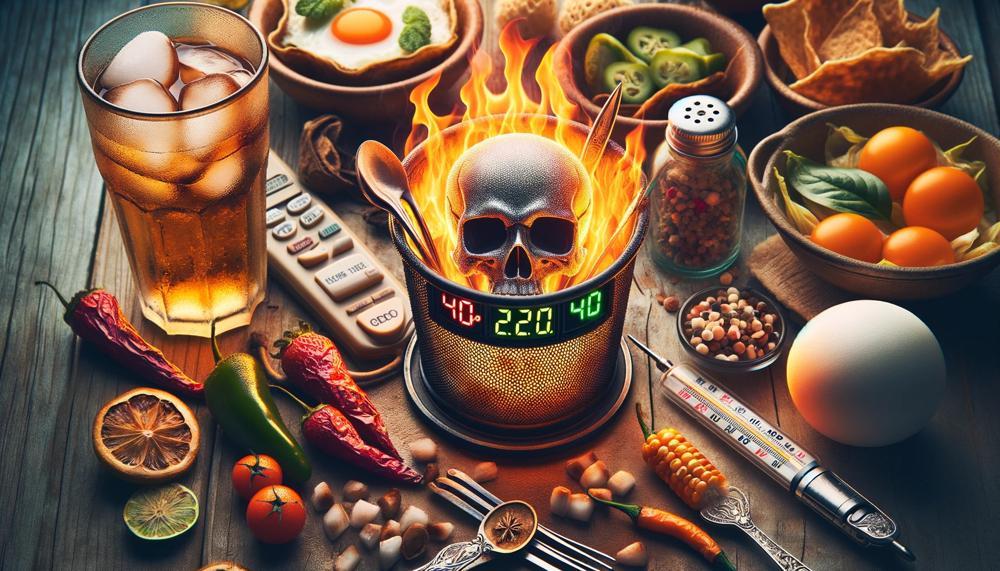As the temperature falls, many grill enthusiasts might wonder how to keep their outdoor cooking game strong without letting the cold put a damper on their barbecue plans.
Here’s where we come in, offering you a hot take on:
- The sweet spot for your Traeger’s performance in chillier climates.
- Must-know tips for maintaining optimal heat and efficiency.
- The no-go zone temperatures where it’s best to wait for a warmer day.
Whether you’re a seasoned pitmaster or a weekend warrior in the world of smoking and grilling, this post is your ticket to ensuring your Traeger thrives in the cold. Get ready to arm yourself with the knowledge to keep those flavors smoking, even when your breath is visible in the air. Let’s dive into the cold, hard facts and keep the fire burning all year round.
Contents
- 1 How Cold Is Too Cold For A Traeger?
- 2 The Importance of Proper Insulation for Traeger Grills in Cold Weather
- 3 Top Accessories to Help Keep Your Traeger Warm in Cold Temperatures
- 4 Tips for Using a Traeger Grill in Extremely Cold Weather Conditions
- 5 Troubleshooting Common Issues When Using a Traeger Grill in Cold Weather
- 6 How Pellet Smokers Handle Cold Weather and Enhance Flavor
- 7 Taking Care of Your Traeger Grill in Winter: Maintenance and Storage Tips
- 8 Conclusion
How Cold Is Too Cold For A Traeger?
A Traeger can be used in cold temperatures, but it’s not as simple as firing it up and throwing on a steak. When the mercury dips, several factors come into play that could affect your Traeger’s performance.
It’s like trying to start a campfire in a snowstorm; possible, but it requires some know-how and preparation.
Understanding the Limits
Traeger grills, marvellous for their versatility, are engineered to perform across a spectrum of conditions. Yet, extreme cold pushes these machines to their limits.
Below freezing, the grill faces hurdles in maintaining temperature, which can impact the succulence of your BBQ.
Insights and Adaptations
| Challenge | Solution | Additional Notes |
| Temperature Control | Use a Thermal Blanket | Helps maintain a consistent temperature. |
| Pellet Consumption | Choose High-Quality Pellets | Reduces the amount of ash and potential blockages. |
| Component Freeze | Shelter and Insulate | Protects against wind and moisture. |
The Importance of Proper Insulation for Traeger Grills in Cold Weather
Insulating your Traeger grill in nippy weather is more than a good idea; it’s a game-changer for your winter BBQs.
Let’s break down why keeping your grill snug as a bug is vital and how it boosts its performance during the cold months.
Heat Retention is Key
| Aspect | Without Insulation | With Proper Insulation |
| Heat Consistency | Heat escapes, leading to fluctuating temperatures | Stable temperatures for even cooking |
| Fuel Efficiency | More pellets consumed to maintain heat | Fewer pellets needed, saving you money |
| Cooking Time | Longer cooking times due to heat loss | Reduced cooking time thanks to efficient heat use |
Gear Up with the Right Accessories
A Traeger Insulation Blanket isn’t just a fancy add-on; it’s a winter warrior’s armour. Crafted from hardy materials, it locks in the warmth, making sure your grill operates efficiently, even when the mercury dips. Plus, it’s a cinch to clean.
Then there’s the Traeger Cold Weather Cover, a nifty shield against the elements, complete with an adjustable drawstring for a snug fit, ensuring your grill stays protected and ready for action.
Top Accessories to Help Keep Your Traeger Warm in Cold Temperatures
To keep your Traeger warm in frosty conditions, a combination of practical accessories and savvy know-how is your best bet. Here, we spotlight essential gear to shield your grill from the chill, ensuring succulent, smoky flavours no matter the weather.
Top Accessories for a Toasty Traeger:
| Accessory | Function | Benefit |
| Insulation Blanket | Heat retention | Reduces pellet use, maintains temperature |
| Grill Cover | Weather protection | Extends grill life, prevents rust |
| Front Folding Shelf | Extra space | Convenience, less exposure to cold |
| Pellet Sensor | Pellet level monitoring | Continuous cooking, no surprises |
| Heat-Resistant Gloves | Protection from heat/cold | Safe handling, better grip |
| Meat Thermometer | Accurate temperature reading | Perfect results, less lid opening |
Armed with these accessories, you’re well-equipped to keep your Traeger hot and your spirits high, even as the temperatures dip.
Tips for Using a Traeger Grill in Extremely Cold Weather Conditions
To ensure your Traeger grill operates optimally in freezing temperatures and still whips up delightful BBQ, heed the following advice:
Insulate Your Grill:
Use a Traeger Insulation Blanket to combat the cold. This accessory is vital for maintaining consistent temperatures and reducing pellet consumption.
Shelter Your Grill:
Position your grill to shield it from cold winds. A sheltered spot minimizes the impact of wind chill and aids in maintaining heat.
Warm-up Time:
Allow extra time for your grill to warm up. In cold weather, it may take 15-20 minutes longer to reach the desired cooking temperature.
Check Pellet Levels:
Ensure the hopper is full to prevent running out mid-cook. Cold weather increases pellet consumption as your grill works harder to maintain heat.
Store Pellets Properly:
Keep your pellets dry and in a sealed container. Moisture can cause them to swell and disrupt performance.
Consider a Heat Source:
In extremely cold temperatures, using a heat lamp or small fire nearby can help maintain the grill’s temperature.
Monitor Food More Frequently:

Cold air can affect cooking times. Regularly check your food’s internal temperature to avoid under or overcooking.
Maintenance:
Before cold weather hits, perform a thorough check of your grill’s parts. Ensure all connections are secure and components are in good condition.
Troubleshooting Common Issues When Using a Traeger Grill in Cold Weather
In the heart of winter, even the most sturdy Traeger grill might throw a curveball or two. Let’s tackle the chilly challenges and keep the BBQ flame alive, shall we?
Here are the common cold-weather culprits and how to knock them out:
| Issue | Symptom | Solution |
| Temperature Fluctuations | Grill struggles to maintain set temperature. | Wrap your grill in a thermal blanket for extra insulation. Keeps it snug and toasty. |
| Ignition Trouble | Grill won’t start or takes longer to ignite. | Ensure it’s plugged in properly and that pellets are aplenty and dry. A clean burn pot helps too. |
| Debris Buildup | Poor performance or uneven cooking. | A thorough scrub down removes grease and gunk, ensuring top-notch performance. |
| Error Codes | Displays “ERR”, “LERR”, or “HERR”. | For sensor woes (“ERR”), reboot. “LERR” hints at ignition issues – check the hot rod. Auger troubles (“HERR”)? Inspect for blockages. |
| Part Failures | Grill functions erratically or not at all. | Parts like the hot rod or ignition switch might need a swap. Don’t fret; they’re easy fixes. |
When Jack Frost is nipping, don’t let your BBQ skills freeze up. A clean, well-insulated grill laughs in the face of the cold. Encounter a stubborn problem? Traeger’s helpline is a beacon in the blizzard.
How Pellet Smokers Handle Cold Weather and Enhance Flavor
Pellet smokers are adept at navigating the challenges of extreme temperatures, ensuring that your BBQ maintains its delectable flavors regardless of the weather’s whims.
| Feature | Benefit | Impact on Flavor |
| Electronic Control | Precise temperature management | Consistent cooking environment enhances flavor |
| Insulation | Efficient heat retention | Even cooking in cold temps without flavor loss |
| Quality Smoke | Clean, consistent smoke from premium pellets | Rich, nuanced flavors from chosen wood type |
| Optimized Airflow | Ensures efficient smoke circulation | Evenly smoked food with a perfect crust |
In essence, pellet smokers are built to tackle the caprices of weather while ensuring your BBQ remains a flavorful feast. Their smart design and technology keep the heat steady and the smoke quality high, guaranteeing that every bite is imbued with the deep, satisfying essence of perfectly smoked BBQ.
Taking Care of Your Traeger Grill in Winter: Maintenance and Storage Tips
When prepping your Traeger grill for a hibernation in the frosty embrace of winter, there’s a knack to ensuring it wakes up as pristine as a spring bloom.
Below are the specifics, served up straightforward, for stashing your grill when the thermometer dips below freezing.
Deep Clean Before the Big Chill
| Cleanliness | Instructions | Benefits |
| Interior scrub | Wipe down the interior with a natural degreaser. Pay attention to the grate, using a wire brush for stubborn grime. | Prevents mould and pest attraction. |
| Pellet Purge | Remove leftover pellets to avoid moisture absorption and potential spoilage. | Ensures smooth operation post-winter. |
| Exterior Wipe | Use a gentle cleaner on the grill’s exterior surfaces. | Maintains the grill’s aesthetic and prevents rust. |
Pellet Protection
Safeguard your pellets like they’re gold dust. Store them in a dry, sealed container away from direct contact with cold concrete or damp surfaces, ensuring they remain dry and ready for your next barbecue bash.
Disconnect and Deter
Unplug your grill to dodge any electrical misadventures. A sprinkle of diatomaceous earth around the hopper acts as a guardian against insect invasions, keeping it clean and critter-free.
Shelter from the Storm
If you’ve got a garage or shed, let it host your grill, shielding it from snow, rain, and ice. No room indoors? A snug-fitting Traeger grill cover, complemented by a sturdy tarp, will fend off the winter elements.
Cold Weather Gear
For those brave souls grilling in the grip of winter, invest in a Traeger Insulation Blanket. It’s like a warm hug for your grill, keeping the heat consistent and your pellets burning efficiently.
By embracing these steps, your Traeger grill will emerge from winter’s chill ready for a sizzling reunion with the spring sun.
Conclusion
Using a Traeger grill during the winter demands a combination of planning, knowledge, and the appropriate supplies. Cold weather puts a strain on your grill and tests its capabilities, but with the right precautions, your Traeger grill can still be the star of a winter cookout.
Stressing the value of insulation—like a thermal blanket—allows for uniform cooking and lower pellet usage by ensuring fuel efficiency and heat constancy. Furthermore, the position of your grill is critical to how well it functions in chilly winds; enough shade reduces the force of the wind.
To guarantee a stable fuel supply and consistent temperatures, using premium pellets and using a pellet sensor can greatly improve your grilling experience. Furthermore, you may counteract the difficulties brought on by cold weather by giving your meal additional time to warm up and by regularly checking its interior temperature.
In winter care, maintenance is also crucial. Proper cleaning and pellet storage will ensure that your grill lasts a long time and is ready for the spring thaw.
The secret is adaptability, whether that means packing for the cold or storing your Traeger until the weather becomes warmer.






